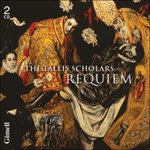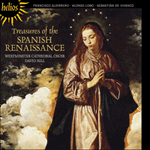Lobo’s
Ave Maria is a masterpiece, being based on a complex canon 8 in 4 at the upper fifth. Although the eight voices are divided into two choirs and the bottom part of each choir sings the same music, the other three voices are rearranged: the top part of the choir which begins becomes the third part in the choir which responds, the second part of choir I becomes the top part of choir II, and the third part of choir I becomes the second part of choir II. Yet despite the mathematical intricacies the resulting music seems artlessly serene, as befits the text. It culminates in the most perfect ‘Amen’, where the beauty inherent in these canons is particularly telling.
from notes by Peter Phillips © 1997
L’
Ave Maria est un chef-d’oeuvre en ce qu’il repose sur un complexe canon 8 en 4, à la quinte supérieure. Quoique les huit voix soient scindées en deux choeurs, et quoique la partie grave de chacun de ces choeurs chante la même musique, les trois autres voix sont réarrangées: la partie supérieure du choeur qui fait l’ouverture devient la troisième partie du choeur qui répond, la deuxième partie du choeur I devient la partie supérieure du choeur II et la troisième partie du choeur I devient la deuxième partie du choeur II. Nonobstant ces intrications mathématiques, la musique semble innocemment sereine, comme il sied au texte. L’oeuvre culmine dans le plus parfait «Amen», où la beauté immanente à ces canons se fait particulièrement évocatrice.
extrait des notes rédigées par Peter Phillips © 1997
Français: Gimell
Lobos
Ave Maria ist ein Meisterwerk, denn es beruht auf einem komplexen Kanon, achtstimmig mit vier Soggetti auf der Oberquinte. Obwohl die acht Stimmen in zwei Chöre aufgeteilt sind und die tiefste Stimme beider Chöre die gleiche Musik singt, sind die jeweils anderen drei Stimmen umgestellt: Die Oberstimme des zuerst einsetzenden Chors wird zur dritten Stimme des antwortenden Chors, die zweite Stimme des ersten Chors wird zur Oberstimme des zweiten Chors und die dritte Stimme des ersten Chors wird zur zweiten des zweiten Chors. Doch trotz aller mathematischen Feinheiten hat die daraus resultierende Musik eine schlichte Gelassenheit, wie sie dem Text gebührt. Sie findet ihren Höhepunkt im vollendeten „Amen“, in dem die diesen Kanons innewohnende Schönheit besonders eindrucksvoll zum Tragen kommt.
aus dem Begleittext von Peter Phillips © 1997
Deutsch: Anne Steeb/Bernd Müller


 Requiem
Requiem Treasures of the Spanish Renaissance
Treasures of the Spanish Renaissance
